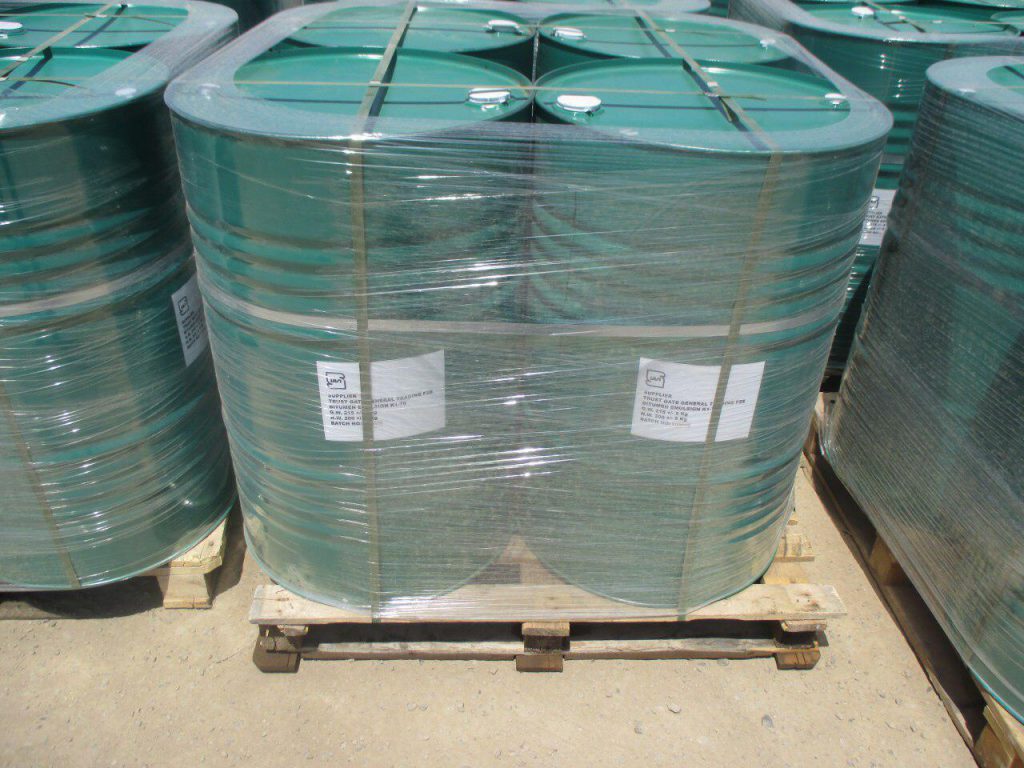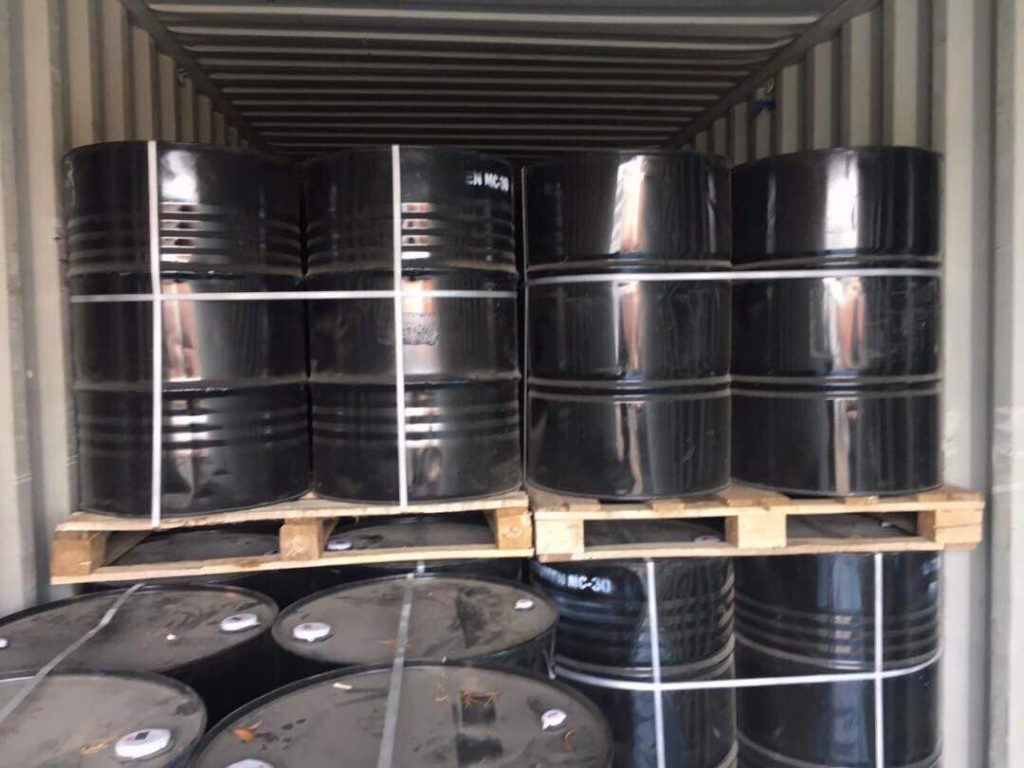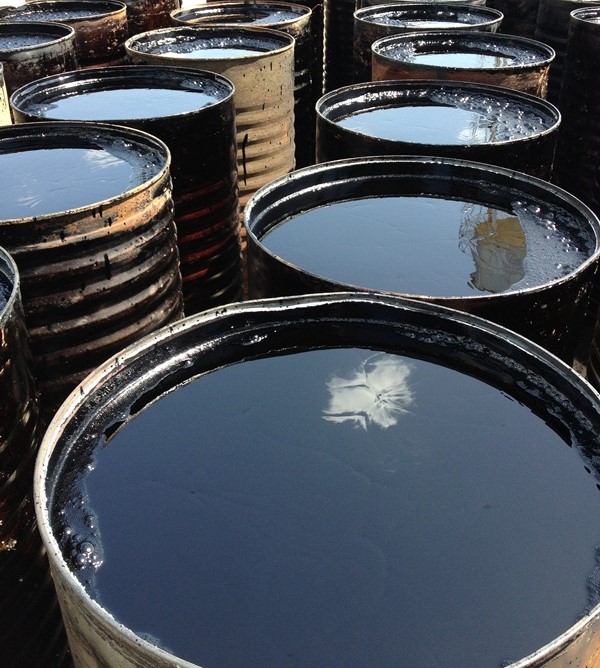Slow Curing Cutback Bitumen
Slow Curing Cutback Bitumen Description

Slow curing Cutback Bitumen and oils of low volatility generally in the heavy distillate range (SC–70, 250, 800, 3000). The degree of liquidity developed in each case depends principally on the proportion of solvent to asphalt cement. To a minor degree, the liquidity of the cutback may be affected by the hardness of the base asphalt from which the cutback is made. The degree of fluidity results in several grades of cutback asphalt some quite fluid at ordinary temperatures and others somewhat more viscous. The more viscous grades may require a small amount of heating to make them fluid enough for construction operations.
Slow Curing often called “road oils,” are usually a residual material produced from the fractional distillation of certain crude petroleums. Traditionally any kind of aromatic, naphthenic and paraffinic oils are used. Slow Curing liquid bitumen materials can be prepared by blending bitumen with an oily petroleum fraction.
Slow Curing Cutback Bitumen Applications
Current common uses are in penetrating prime coats and in producing patching or stockpile mixtures. Cutback asphalt used in mixing with aggregate will usually contain an adhesion agent to assist in the coating of the aggregate surface.
Cutback agents are used to lowering the viscosity of bitumen when it is applied as a primer to the surface of a road pavement aggregate base course or substrate. Kerosene is used as a bitumen cutback agent at different concentrations according to local conditions and requirements.
The cutback bitumen is ideal for prime coat and cold applied because of easy uses and no need to thinning and heating.
Cutback bitumen SC consist of initial incorporation of asphalt into the surface of non-asphalt based course preparatory to any superimposed treatment of construction.
The cutback asphalt SC applying to waterproofing of surfaces, plug capillary voids, coat and bond loose mineral particles.
Slow curing (SC) cutback asphalt cement and oils of low volatility generally in the heavy distillate range (SC-70, 250, 800, 3000). The degree of liquidity developed in each case depends principally on the proportion of solvent to asphalt cement. To a minor degree, the liquidity of the cutback may be affected by the hardness of the base asphalt from which the cutback is made. The degree of fluidity results in several grades of cutback asphalt—some quite fluid at ordinary temperatures and others somewhat more viscous. The more viscous grades may require a small amount of heating to make them fluid enough for construction operations.
Slow curing (SC) cutback asphalt are often called road oils and are used primarily in road-mixing and dust-laying applications. This term originated in earlier days when asphalt residual oil was used to give roads a low-cost, all-weather surface. SC cutback asphalts are also used for stockpile patching mixes, plant-mixed with graded aggregates and occasionally for priming.
Medium Curing Cutback Bitumen
Medium Curing Cutback Bitumen Description

Medium Curing Cutback Bitumen is a compound of different oil solvents such as kerosene in order to transform bitumen to soluble bitumen which is evaporated in oil solvent using process and the bituminous layer is remained to make cohesion, penetration and form a sealing layer. A famous sort of it known as MC250 or liquid bitumen in asphalt section including pavement (cohesive between 2 Tack coat asphaltic layers), cold asphalt (Roadmix) and substructure (cohesive between asphaltic and soil layers-Prime coat) has been previously used. Available kerosene in MC250 would lead to promoting bitumen restoration, better penetration in infrastructure application (Primecoat) but yet will increase environmental hazards, price and heating cost in using and discharging time comparison with various types of water-based emulsions. Bitucut bitumen is produced and supplied in these types: MC800, MC250, MC70, MC30 and MC3000 which have the different percentage of solvent. Bitucut usage differs in various conditions such as substructure (continuous grading with low free space, open grading, and soil percentage). Using Bitucut in substructures (Primecoat) is the most demanded application.
Medium curing (MC) cutback asphalts are defined as those asphalt grades, which are prepared by using the medium volatile kerosene as the prime coat with boiling point ranges (MC-30, 70, 250, 800, 3000). The mix is done in a cold manner.
Cutback bitumen or asphalt is classified based on the curing as follows, 1) Slow, 2) medium and 3) rapid curing.
The degree of evaporation in the medium curing cutback asphalt is intermediate because the kerosene is intermediate volatile liquid as compared to the naphtha and diesel. The degree of liquidity depends on the proportion in which the kerosene is mixed in the asphalt cement.
The following specification for the medium curing cutback asphalt with its properties are as given below.
The medium curing cutback asphalt is used in the flexible pavements for surface dressing, prime coating, and tack coating. Evaporation of the solvents will be at a moderate rate. This grade is used with aggregates for ensuring better work-ability in the mix.
The degree of liquidity developed in each case depends principally on the proportion of solvent to asphalt cement. To a minor degree, the liquidity of the cutback may be affected by the hardness of the base asphalt from which the cutback is made. The degree of fluidity results in several grades of cutback asphalt—some quite fluid at ordinary temperatures and others somewhat more viscous. The more viscous grades may require a small amount of heating to make them fluid enough for construction operations.
The medium setting grades are designed for mixing with aggregates. Because these grades do not break immediately upon contact with aggregate, mixes using them can remain workable for extended periods of time and lend themselves to cold mix stockpiles.
Medium Curing Cutback Bitumen Applications
The medium setting grades are designed for mixing with aggregates. Because these grades do not break immediately upon contact with aggregate, mixes using them can remain workable for extended periods of time and lend themselves to cold mix stockpiles.
A cutback bitumen medium curing MC is simply a combination of asphalt cement and petroleum solvent. Like emulsions, cutbacks are used because they reduce asphalt viscosity for lower temperature uses (tack coats, fog seals, slurry seals, stabilization material).
Similar to emulsified asphalts, after a cutback asphalt is applied the petroleum solvent evaporates leaving behind asphalt cement residue on the surface to which it was applied. Cutback asphalt is said to “cure” as the petroleum solvent evaporates away. The use of cutback asphalts is decreasing because of environmental regulations.
MC Cutback Bitumen Packing
Packing of MC Cutback Bitumen is in new thick steel drums on pallet to prevent any leak inside of container also bulk in bitutainer and tanker.
Rapid Curing Cutback Bitumen
Rapid Curing Cutback Bitumen Description

Rapid curing cutback Bitumen cement is a combination of light diluents of high volatility, generally in the gasoline or naphtha boiling point range (RC-70, 250, 800, 3000), and asphalt cement.
Cut-back asphalts is defined as the bitumen whose viscosity value will be greatly reduced by the addition of volatile diluents (high viscosity). It mainly depends upon the diluents used. Generally, three types of cutbacks are used as follows, 1) rapid curing, 2) medium curing and 3) slow curing.
Rapid curing cutback asphalt combinations are prepared starting from the lighter diluents, and even from the fluid of higher viscosity. The grades used for rapid curing cutback bitumen are RC-70, RC-250, RC-800 and RC-3000. Here, the value given by numbers 70, 250, 800, and 3,000 represents the kinematic viscosity of the bitumen given in centistokes. The solvent concentration of rapid curing asphalt is 15-45% of the volume of asphalt cement used.
Different degrees of fluidity exists for each case and it depends on the proportion of the solvent of asphalt cement. In a minor degree cutback, liquidity may get affected by the hardness of base asphalt from which the cutback is made. It is used for the prime coats.
It is used in the pavement design process. It reacts quickly for the spray applications of bond and tack coats. It is helpful to seal the aggregate chips and sand seals. Rapid curing asphalts are mainly used for surface treatment.
Cut back asphalt RC 800 is useful for waterproofing surfaces and plug capillary voids. Grade RC250 acts as a seal coat in roadway pavements.
Mainly two tests are conducted on cut-back asphalt and are given as 1) residue and 2) cut back test. The testing of residue focusses on examination of penetration, ductility, and solubility. The testing of cutback bitumen includes the distillation, viscosity and flash point tests.
The degree of liquidity developed in each case depends principally on the proportion of solvent to asphalt cement. To a minor degree, the liquidity of the cutback may be affected by the hardness of the base asphalt from which the cutback is made. The degree of fluidity results in several grades of cutback asphalt—some quite fluid at ordinary temperatures and others somewhat more viscous. The more viscous grades may require a small amount of heating to make them fluid enough for construction operations.
Cutback Bitumen Rapid Curing Applications
Rapid Curing Cutback Bitumen is made by reducing the viscosity of and ordinary bitumen by adding mostly petroleum type solvent. Cutback Bitumen are used because their viscosity is lower than that of neat asphalt and can thus be used in low-temperature applications.
The rapid-setting grades are designed to react quickly primarily for spray applications, such as bond/tack coats, aggregate chips seals, sand seals and similar surface treatments.
Rapid curing Cutback bitumen are typically used as prime coats and tack coats. Generally, Cutback Bitumen are divided into three groups depending on their volatility of the solvent added
After a RC cutback is applied the solvent evaporates away and only the Bitumen is left. A rapid curing cutback bitumen is said to cure as the petroleum solvent evaporates.
RC Cutback Bitumen Packing
Bulk as IBC Tank, Flexi Tank
Reconditioned steel drums 220 lit., Net Weight: 191 ± 3 Kg
New steel drums 220 lit., Net Weight: 191 ± 3 Kg
RC Cutback Bitumen Safety
Refer to Safety Data sheets before use.
Transport, use and store at the lowest temperature possible.
Eliminate all potential ignition sources during application.
Avoid breathing vapors. Avoid contact with skin.
Always wear appropriate PPE including heat protection when used hot.
DO NOT allow product or washings to enter stormwater or sewer systems.
Cutback Bitumen
Cutback Bitumen Description

Cutback Bitumen ( Liquid Bitumen ) is Bitumen that is dissolved in a solvent. Typical solvents include Naphtha, gasoline and kerosene, white spirit etc. The type of solvent controls the curing time while the amount determines the viscosity of the Liquid Bitumen. Bitumen is ‘cutback’ by adding controlled amounts of petroleum distillates such as kerosene. This is done to reduce the viscosity of the bitumen temporarily so it can penetrate pavements more effectively or to allow spraying at temperatures that are too cold for successful sprayed sealing with neat bitumen. The materials used to cutback bitumen will evaporate after application to leave the remaining material similar in hardness to the original bitumen.
Cutback bitumen is a range of binders that are produced by blending (mixing) penetration grade bitumen and a hydrocarbon solvent, such as paraffin or mineral turpentine.
When the solvent has evaporated, the binder returns to its original penetration grade to tie the particles together. Cutback bitumen gets its name from the solvent that is involved in the process, because the solvent “cuts back” or evaporates, leaving behind the binder to “get on with the job”. The solvent used in cutback bitumen is called the “cutter” or “flux”.
Three types of solvents are used for the blending process: slow-curing, medium-curing or rapid-curing solvents. The latter two are the most common in South Africa. The choice of the solvent determines the rate at which the bitumen will cure when exposed to air. A rapid-curing (RC) solvent will evaporate faster than a medium-curing (MC) solvent. Curing relates to the evaporation rate of the solvent which influences the setting time of the bitumen. The viscosity of the cutback bitumen is determined by the proportion of solvent added: the higher the proportion of solvent, the lower the viscosity of the cutback.
Cutbacks differ from penetration grade bitumen in that they are more workable — in other words, they can be more easily reshaped. Less heat is required to liquefy cutback bitumen than penetration bitumen, making it easier to use at lower temperatures.
Typical cutback bitumens are MC 30 and RC 250. The letters in the name refer to the curing action of the solvent, and the number to the viscosity of the binder.
Cutback bitumen is classified based on viscosity grade. It is divided into three categories:
1- Rapid-Curing (RC) :The cutback bitumen is known as rapid-curing (RC) if the bitumen is solved in gasoline. The reason is that evaporation occurs quickly and the bitumen is deposited.
2- Medium-Curing (MC) :MC cutbacks are prepared by solving bitumen in kerosene which evaporates more slowly than gasoline.
3- Slow-Curing (SC) :Slow-curing cutback may be achieved from solving bitumen in gasoil or fuel oil or directly from distillation of crude oil.
Application of Cutback Bitumen
Cutback bitumens suitable for primer sealing can also be used in the manufacture of pre-mix asphalt, which is used in patch repairs. Cutback bitumens are used extensively in sprayed sealing applications, particularly in cooler weather where they provide improved initial stone retention due to their lower viscosity. Typically, a single application of the appropriate cutback bitumen is sprayed onto the primed pavement onto which aggregate is laid.
Prime and Tack Coating
The process of priming involves applying a low viscosity binder to a prepared but usually unbound aggregate base. It is intended to be absorbed by the top layers of the base and provide a surface more easily ‘wetted’ by a subsequent bituminous covering. The primer will be able to carry traffic for a short time (although this practice is uncommon) and help control dust. Generally, primers are applied at rates between 0.5 and 1.4 L/m2. Cutback bitumens suitable for priming are also used for tack coats, which are applied to an underlying surface to help with the adhesion of subsequent asphalt layer. A typical application rate is between 0.2 and 0.4 L/m2.
Prime Sealing
Where temperatures are too cool for an effective priming operation, or where traffic is likely to upset a primed surface before the final seal can be sprayed, a primer seal can be used to give adequate protection of the pavement for periods of up to 6 to 12 months. Cutback bitumens suitable for primer sealing can also be used in the manufacture of pre-mix asphalt, which is used in patch repairs.
Spray Sealing
Cutback bitumens are used extensively in sprayed sealing applications, particularly in cooler weather where they provide improved initial stone retention due to their lower viscosity. Typically, a single application of the appropriate cutback bitumen is sprayed onto the primed pavement onto which aggregate is laid.
HJ Oil GRUOP supplies and provides transfer of technology for production of all cutback Bitumens in correspondence to ASTM D2026, D2027, D2028, AASHTO M82-75 (2008), AASHTO M92-92 (2008). For any inquiries, please contact our sales team on info@www.hjoilgroup.com
- Slow Curing Cutbacks (ASTM D2026)
- Medium Curing Cutbacks (ASTM D2027 or AASHTO M82-75 2008)
- Rapid Curing Cutbacks (ASTM D2028 or AASHTO M81-92 2008)
USES OF CUTBACK & EMULSION BITUMEN IN DIFFERENT SYSTEMS OF ROAD MAINTENANCE
| System | Description & Uses | Recomende Product |
| SurfaceDressing | An application of binder on the road surface by a bitumen distributor followed by a covering of aggregates/chippings spread by a hopper gritter. Can be a single or double-layer surface dressing | Cutback: MC -3000 |
| Prime Coating | An application of binder on a granular base to prepare for an asphalt surfacing .Normally a slow setting emulsion or cutback is used for better penetration purposes to seal off the road base. The rate of application can vary from 0.4-1.4 liter/m2 | Cutback : MC-30 MC -70 |
| Tack Coating | A very light application of binder –hand or machine sprayed –to ensure bonding between the existing layer and the new overlay. The rate of application is normally between 0.25-0.7 liter/m2, depending on the surface being sprayed | Emulsion: K1-40 : RS-1K: RS-2K |
| Semi– Grouting /Penetration Macadam | An application of hot binder on a compacted layer of coarse aggregate | Emulsion : RS-3K : MC-3000 Other : Bitumen |
| Slurry Sealing | A maintenance technique where specially tailored emulsion, aggregates, water, and /or mineral filler is mixed in an on-site distributor and spread on an existing road surface at a thickness of 3-6 mm. It is both a preventive and corrective maintenance method for sealing of surface cracks, waterproofing asphalt surfaces and stopping oxidation | Emulsion: ALFA/SS |
| Fog Sealing /Mist Spraying | It is similar to tack coating in that is a very light application of diluted emulsion for renewal/rejuvenation of old asphalt surfaces. The emulsion is usually diluted to a concentration of about 25-30% binder and applied at a rate of 0.3-0.8 liter/m2 | Emulsion : K1-40 : SS-1K : ALFA |
| Dust Binding | A light application of 0.5-2.0 liter/m2 using diluted bitumen emulsion for dust control on unpaved roads | Emulsion: K1-40: SS-1K |
